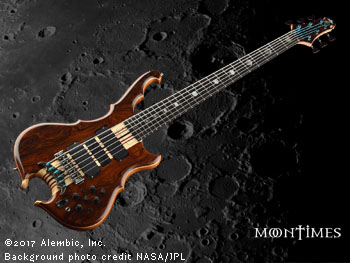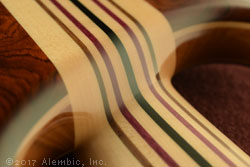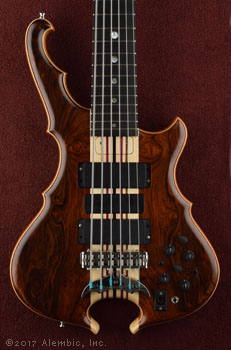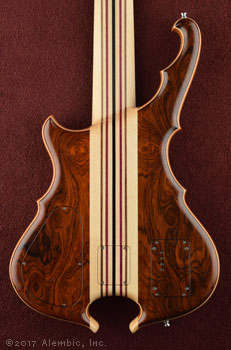
|
SPECIFICATIONS
- Series II 6-string bass
- Coco Bolo top
- Coco Bolo back
- Bird of Prey II body shape
- Kobby peghead shape
- Maple, Purpleheart, Walnut, and Ebony neck
- 35" scale
- Ebony fingerboard
- Phases of the Moon fingerboard inlays
- Man in the Moon secret medallion inlay
- Inlaid logo
- Continuous wood backplates
- Continuous wood truss rod cover
- Ruthenium plated hardware
- Bird of Prey tailpiece shape
- Series II electronics with master volume and pan configuration
|


Wallpaper:
1600x1200
1280x1024
1024x768
800x600
Widescreen:
2560x1440
1920x1200
1680x1050
1600x900
Text by Mica Wickersham Thomas © 2017 Alembic, Inc.
Photos of bass by Mica Wickersham Thomas, © 2017 Alembic, Inc.
Photo of the moon by NASA/JPL Galileo 1992
|

|
This view of the north polar region of the Moon was obtained by Galileo's camera during the spacecraft's flyby of the Earth-Moon system on December 7 and 8, 1992. The north pole is to the lower right of the image. The view in the upper left is toward the horizon across the volcanic lava plains of Mare Imbrium. The prominent crater with the central peak is Pythagoras, an impact crater some 130 kilometers (80 miles) in diameter. The image was taken at a distance of 121,000 kilometers (75,000 miles) from the Moon through the violet filter of Galileo's imaging system. According to team scientists, the viewing geometry provided by the spacecraft's pass over the north pole and the low sun-angle illumination provide a unique opportunity to assess the geologic relationships among the smooth plains, cratered terrain and impact ejecta deposits in this region of the Moon. JPL manages the Galileo Project for NASA's Office of Space Science and Applications.
|



 With the wide custom fingerboard, we worked out a nice deep carved heel for Dave's bass. This makes the upper fret access a total breeze.
With the wide custom fingerboard, we worked out a nice deep carved heel for Dave's bass. This makes the upper fret access a total breeze.




